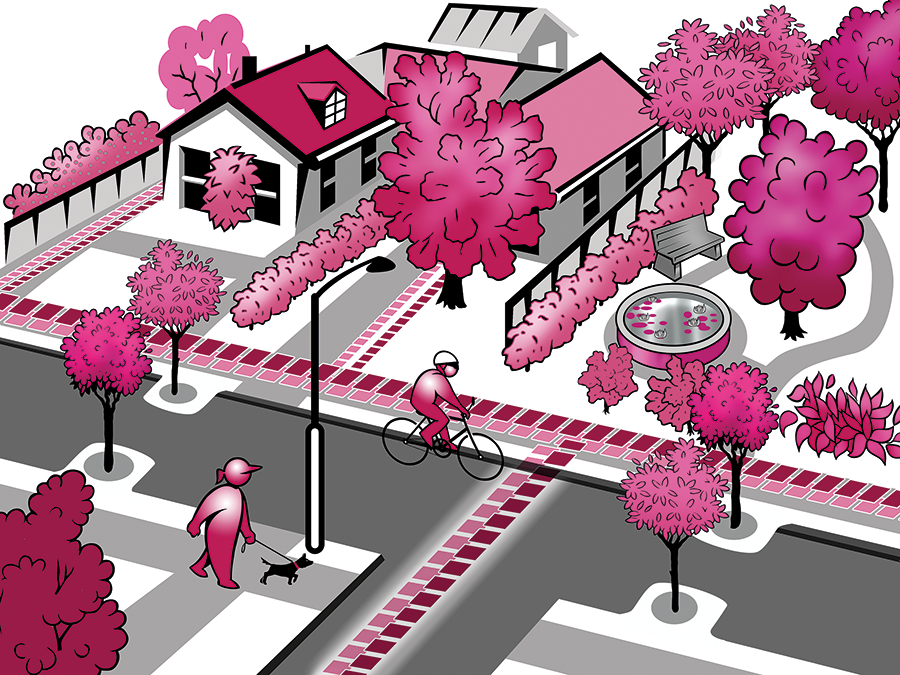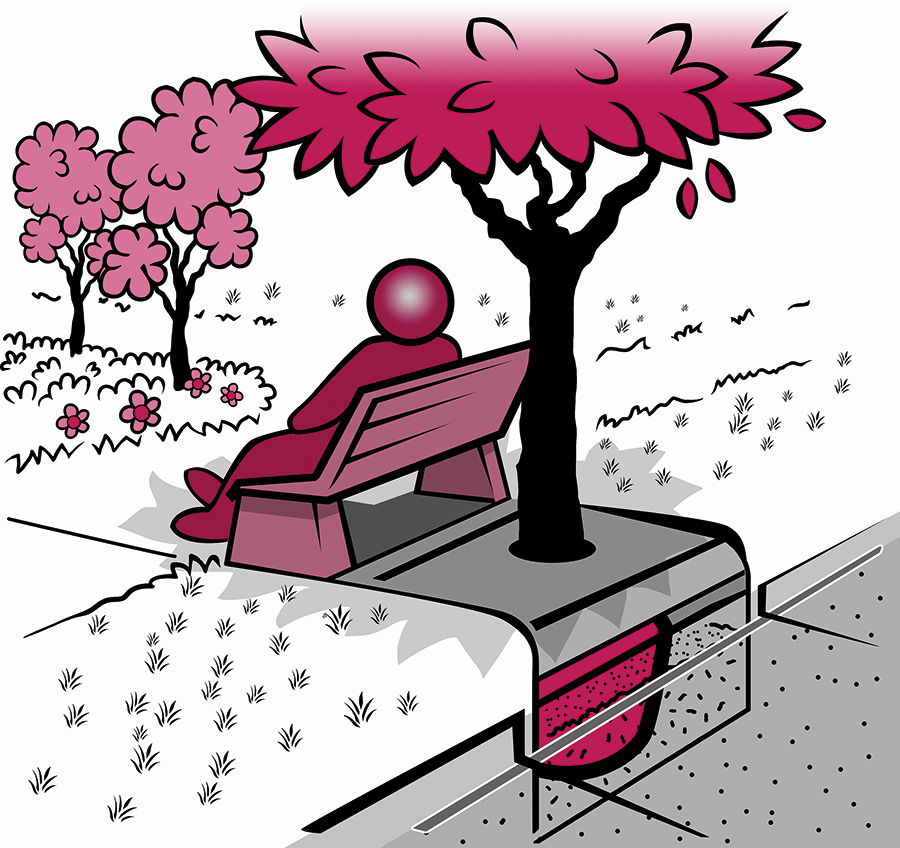#  Streets and the
Streets and the
Public Realm
Subdivision design can respond to a variety of sustainability outcomes to create a people focused local street network and public realm to encourage walking whilst increasing biodiversity and mitigating the urban heat island effect.
# Why do subdivisions need to focus on people when designing streets and public realm?
Designing streets and public realm with a focus on people is seen as one of the most influential contributors to sustainable subdivisions. If the streets and public realm are designed right, there will be flow on benefits to each of the other six opportunity areas, including: Site Layout and Liveability, Energy, Ecology, Integrated Water Management, Urban Heat and Circular Economy (Materials and Waste).
Designing people focused streets and open space, including playgrounds, parks and sporting fields, sets the preconditions to create pedestrian and bicycle friendly neighbourhoods in which people of all abilities can easily and safely move around.
The local street network should be seen as more than conduits for movement of vehicles. Prioritising people and active transport modes rather than vehicle traffic will enable long term behavioural change and improve the amenity of new neighbourhoods. This will result in the transition to low emission, low pollution alternatives that enable healthier communities.
Public Realm can be designed as inviting, vibrant places that support local community and economy, and drive biodiversity, urban cooling, and integrated water management outcomes.
 Designing people-focused streets and open spaces creates neighbourhoods where people of all abilities can move around easily and safely.
Designing people-focused streets and open spaces creates neighbourhoods where people of all abilities can move around easily and safely.
# Benefits of people focused streets and public realm
Developers can take advantage of:
- Enhanced market appeal of the subdivision to prospective purchasers
- Demonstrating best practice in creating climate resilient neighbourhoods
A new resident can expect:
- Better health and wellbeing resulting from pedestrian focused streets
- A safer, more visually interesting public realm
- Improved environmental outcomes in streets and open spaces
- Improved connection to place, having access to improved streets and public realm which create a sense of community
“ When designing streets and public realm that are people focused, there are significant opportunities to also enhance biodiversity and mitigate urban heat. However, it ultimately also supports reducing transport related emissions by creating streets that are accessible to people of all abilities. ”
# People focus
Designing streets and public realm with future residents in mind will strongly influence outcomes in this category. People focused streets and public realm principles include:
- Designing and constructing footpaths, shared path and cycle path networks that are safe, comfortable, well-constructed and accessible for people with disabilities
- Ensuring that streetscape liveability is prioritised by underground service design
- Encouraging walking to local destinations
- Creating pockets of nature with seats for resting and shade from trees to improve the streetscape, comfort, amenity and increase biodiversity
- Encouraging the integration of cultural heritage in public realm design to contribute to a unique and valued sense of place
- Ensuring the delivery of the public realm is high amenity, diverse and visually interesting
- Reducing transport related carbon emissions
By designing a diversity in streets, limiting the length of street blocks (200m for a priority pedestrian street) and including visual interest and rest nodes in the landscape, residents are encouraged to utilise the spaces.
Designing people focused streets and public realm have a high degree of influence in the overall liveability of the neighbourhood by creating high amenity streets that encourage walking and cycling and community interaction.
By reconsidering the way the underground services are designed, there are opportunities to increase the number and size of trees and create space for water sensitive urban design in the streetscape to improve overall amenity.
# Environmental Co-benefits
Designing people focused streets and public realm will have significant co-benefits and will impact on the ability of the subdivision to achieve positive environmental outcomes. Principles relating to environmental co-benefits include providing green infrastructure for a range of ecosystem services (including CO2 reduction and habitat for biodiversity), to reduce the heat island effect and to provide shade for active transport pathways.
 Tree pits with seating offer a place for shade as well as passive irrigation, aiding stormwater management, improving water quality, and enhancing tree growth.
Tree pits with seating offer a place for shade as well as passive irrigation, aiding stormwater management, improving water quality, and enhancing tree growth.
# Case study
| Location | Elmwood Living, City of Wodonga (opens new window) |
| Site Area | 2.4 ha |
| Number of Dwellings | 127 |
| Development Type | Residential |
| Year / Status | 2009 / Ongoing |
| Sustainability Accreditation | No specific accreditation |
| Key Stakeholders | Lightwood Group (Development) |
| Key Features | -Central open space including community garden and kitchen to provide a place for the community to interact. -Connections to the existing neighbouring residential subdivisions through a physically integrated and direct movement/street network. -A high density of street trees to provide canopy cover and shading for residents. -A diversity of footpath and carriageway placement to provide a varied streetscape. -Short front street setbacks to promote community interaction. -Creation of local destinations such as a cafe and medical centre to increase walkability. |
DISCLAIMER: This Fact Sheet has been created for general information purposes only. While the Fact Sheet has been created with all due care, no warranty is given as to its suitability for any particular purpose and users should obtain their own advice relevant to their situation and specific needs. MAV or any party authorised by MAV to reproduce the Fact Sheet is not responsible for the accuracy, currency or reliability of the Fact Sheet and accepts no liability for any damage, losses whether direct or indirect, claims or expenses howsoever arising from any party who may rely on its contents.
The Council Alliance of a Sustainable Built Environment (CASBE) maintains these Sustainable Design fact sheets on behalf of our member councils. (opens new window)
CASBE is supported by the Municipal Association of Victoria (MAV).
Copyright © Municipal Association of Victoria 2025